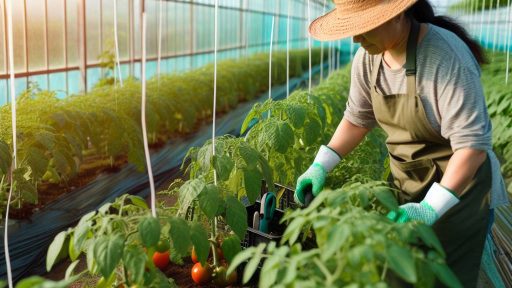Introduction to Sustainable Land Development and the Importance of Weed Control
Sustainable land development focuses on efficient resource use.
It aims to foster ecological balance and support healthy ecosystems.
Effective weed control plays a crucial role in this process.
Weeds often compete with native plants for nutrients and water.
Consequently, unchecked weed growth can lead to biodiversity loss.
Moreover, they can impede the growth of economically valuable crops.
Weed control techniques help maintain both agricultural and natural landscapes.
This control contributes to sustainable practices by enhancing soil health.
Healthy soil is essential for productive land development.
Various weed management strategies exist to ensure success.
Integrating cultural, mechanical, and biological methods proves effective.
These methods minimize chemical use, reducing environmental harm.
For example, planting cover crops can suppress weed growth.
Additionally, using mulch can prevent weeds from establishing.
Community engagement is vital for successful weed management.
Transform Your Agribusiness
Unlock your farm's potential with expert advice tailored to your needs. Get actionable steps that drive real results.
Get StartedOrganizations can educate landowners on sustainable practices.
Furthermore, local governments can promote policies supporting weed control initiatives.
In sum, weed control is essential for sustainable land development.
By managing weeds effectively, we protect our natural resources.
Thus, promoting ecological health and agricultural productivity becomes possible.
Overview of Sustainable Land Development Practices
Definition and Importance
Sustainable land development balances environmental, social, and economic needs.
This approach conserves resources for future generations.
It fosters healthy ecosystems and vibrant communities.
Furthermore, sustainable practices enhance resilience against climate change.
Key Principles of Sustainable Land Development
First, responsible land use mitigates habitat loss and protects biodiversity.
Next, community involvement ensures long-term success of development projects.
Additionally, integrating green spaces improves urban environments.
Moreover, energy efficiency reduces the overall carbon footprint.
Finally, sustainable materials minimize environmental impacts during construction.
Examples of Sustainable Practices
Many municipalities adopt smart growth strategies to manage urban sprawl.
For instance, land trusts help preserve open spaces and natural habitats.
Another example includes mixed-use developments that promote walkability.
Moreover, rainwater harvesting systems enhance water conservation efforts.
Community gardens also contribute to food security and local ecosystems.
Challenges in Sustainable Land Development
Implementing sustainable practices can face significant challenges.
For example, financial constraints may limit resources available for projects.
Additionally, political resistance often impacts policy changes.
Cohesive community engagement is vital but can be difficult to achieve.
Moreover, balancing development with environmental protection remains a complex issue.
Showcase Your Farming Business
Publish your professional farming services profile on our blog for a one-time fee of $200 and reach a dedicated audience of farmers and agribusiness owners.
Publish Your ProfileThe Future of Sustainable Land Development
The future promises increased innovation in sustainable techniques.
Technology will play a key role in efficiency and monitoring.
Growing awareness about climate change may drive policy changes.
Collaboration among stakeholders will enhance project outcomes.
Ultimately, sustainable land development will benefit society as a whole.
The Impact of Weeds on Soil Health and Crop Yield
Introduction to Weeds
Weeds are unwanted plants that compete with crops for resources.
These plants can degrade soil health significantly.
Moreover, they reduce crop yields, impacting food production.
Competition for Resources
Weeds consume essential nutrients from the soil.
This deprives crops of the nutrients necessary for growth.
Additionally, weeds compete for water, leading to drought stress.
Effective weed control thus enhances resource availability for crops.
Impact on Soil Health
Weeds can affect the soil’s physical, chemical, and biological properties.
Some weeds create dense mats that hinder soil aeration.
These mats can also impede water infiltration and drainage.
Consequently, soil may become compacted, limiting root growth.
Moreover, weeds often contribute to soil erosion.
In contrast, controlling weeds promotes healthier soil ecosystems.
Influence on Crop Yield
Weeds can drastically reduce crop yields over time.
They limit available sunlight, which crops need for photosynthesis.
Also, certain weed species harbor pests and diseases.
This can lead to additional challenges for farmers.
Effective weed management can thus lead to higher yields.
Effective Weed Management Strategies
Various strategies simplify effective weed management in agriculture.
Mechanical methods include tilling and mowing weeds.
Chemical methods utilize herbicides, allowing for targeted control.
Integrating cover crops can also suppress weed growth.
Ultimately, a combination of methods is most effective.
Delve into the Subject: Fertilizer Management for Sustainable Wheat Farming in the USA
Methods of Weed Control: Chemical vs. Organic Approaches
Overview of Weed Control Methods
Weed control is essential for sustainable land development.
It influences plant health and crop yield.
We can categorize weed control methods into chemical and organic approaches.
Chemical Approaches to Weed Control
Chemical approaches involve the use of herbicides.
These chemicals target specific weed species to inhibit their growth.
They can quickly reduce weed populations.
However, reliance on herbicides raises environmental concerns.
Some harmful effects include soil degradation and water pollution.
Moreover, they can lead to the development of herbicide-resistant weed strains.
Advantages of Chemical Weed Control
Chemical weed control can provide immediate results.
It often requires less labor compared to manual methods.
Showcase Your Farming Business
Publish your professional farming services profile on our blog for a one-time fee of $200 and reach a dedicated audience of farmers and agribusiness owners.
Publish Your ProfileAdditionally, it can cover large areas effectively.
Disadvantages of Chemical Weed Control
Despite its effectiveness, chemical methods have drawbacks.
They can harm non-target plant species and beneficial insects.
Furthermore, the chemicals can affect soil health negatively.
Long-term use can disrupt ecosystems, leading to imbalances.
Organic Approaches to Weed Control
Organic weed control focuses on natural methods.
It involves practices such as mulching and manual weeding.
These methods promote soil health and biodiversity.
Organic approaches reduce chemical inputs, benefiting the environment.
Advantages of Organic Weed Control
Organic methods enhance soil health over time.
They support beneficial organisms in the ecosystem.
Additionally, these practices can increase long-term agricultural sustainability.
Disadvantages of Organic Weed Control
Organic weed control may require more labor and time.
It can be less effective against certain aggressive weed species.
Moreover, farmers may face challenges in managing weed populations.
Choosing the Right Approach
Deciding between chemical and organic methods depends on various factors.
Considerations include the type of crop, weed species, and environmental impact.
Employing an integrated approach can often yield the best results.
This strategy combines both chemical and organic methods effectively.
Learn More: Greenhouse Cultivation for Reducing Water Usage in Agriculture
Integrating Cover Crops and Mulching for Effective Weed Management
Benefits of Cover Crops
Cover crops enhance soil health by reducing erosion.
They naturally suppress weeds, limiting their growth.
Additionally, they improve nutrient availability in the soil.
Cover crops create a habitat for beneficial insects.
Overall, they contribute significantly to sustainable farming practices.
Choosing the Right Cover Crops
Selecting appropriate cover crops is vital for success.
Consider using clover, rye, or vetch for optimal results.
These plants thrive in various soil types and climates.
Furthermore, they provide specific benefits, like nitrogen fixation.
Incorporating diversity in cover crops enhances soil resilience.
Importance of Mulching
Mulching serves as a protective layer for the soil.
It helps retain moisture during dry periods.
Moreover, it reduces soil temperature fluctuations, benefiting plants.
Effective mulching minimizes weed emergence by blocking sunlight.
It also contributes organic matter to the soil over time.
Types of Mulch Materials
Various materials can be used for mulching.
Organic options include straw, wood chips, and grass clippings.
Inorganic materials, like plastic sheets, can be effective as well.
Choose materials based on local availability and budget.
Each type of mulch has its own set of advantages.
Showcase Your Farming Business
Publish your professional farming services profile on our blog for a one-time fee of $200 and reach a dedicated audience of farmers and agribusiness owners.
Publish Your ProfileImplementing an Integrated Approach
Combining cover crops and mulching creates a synergistic effect.
This method enhances soil structure and fertility.
It effectively controls weed growth throughout the growing season.
Moreover, it significantly reduces the need for chemical herbicides.
By integrating these practices, farmers can achieve sustainability.
Delve into the Subject: Pest And Disease Forecasting For Effective Crop Management
The Role of Herbicide Resistance in Weed Control Strategies
Understanding Herbicide Resistance
Herbicide resistance refers to the ability of weed populations to survive herbicide applications.
This resistance occurs due to genetic mutations in the weeds.
Consequently, these mutations provide survival advantages against common herbicides.
Impact on Weed Control Strategies
Herbicide resistance complicates weed management for farmers and land developers.
It necessitates the development of more effective weed control strategies.
For example, integrated weed management focuses on combining several control methods.
These might include cultural practices, mechanical control, and biological interventions.
Implementing Diverse Control Methods
Diversifying control methods reduces the likelihood of resistance developing.
Farmers can rotate different types of herbicides with various active ingredients.
Additionally, they can use herbicides in combination with non-chemical practices.
- Crop rotation helps disrupt weed life cycles.
- Cover cropping can suppress weed growth.
- Mechanical tillage might be used to physically remove weeds.
Monitoring and Management Practices
Continuous monitoring of weed populations is essential.
Farmers should regularly assess the effectiveness of their control measures.
This monitoring allows for timely adjustments in management practices.
Future Directions in Weed Management
Research and technology play crucial roles in managing herbicide resistance.
Developing new herbicides can provide alternative options for weed control.
Moreover, enhancing genetic understanding of weeds can lead to targeted strategies.
Ultimately, these efforts contribute to more sustainable land development practices.
Delve into the Subject: Essential Mulching Practices for Successful Farming

Case Studies: Successful Weed Control Practices in Sustainable Agriculture
Innovative Approaches in California
In California, farmers have adopted integrated weed management strategies.
This method combines mechanical, cultural, and biological controls.
For instance, cover crops effectively suppress weed growth.
Farmers have reported reduced herbicide use as a result.
Consequently, the soil health has improved dramatically.
Community Involvement in Oregon
In Oregon, community programs empower local farmers.
These initiatives focus on educating farmers about sustainable practices.
Workshops feature successful case studies and practical demonstrations.
Farmers share ideas and collaborate to face common challenges.
Moreover, this approach fosters a supportive agricultural community.
Successful Herbicide Alternatives in Texas
In Texas, farmers are shifting towards organic weed control methods.
They use natural herbicides derived from plant extracts.
These alternatives are less harmful to the environment.
Farmers are experimenting with mulching techniques as well.
This method not only controls weeds but also adds nutrients to the soil.
Crop Rotation Success Stories in the Midwest
Farmers in the Midwest have embraced crop rotation strategies.
Showcase Your Farming Business
Publish your professional farming services profile on our blog for a one-time fee of $200 and reach a dedicated audience of farmers and agribusiness owners.
Publish Your ProfileThis practice disrupts weed life cycles and prevents infestations.
Planting diverse crops enhances soil fertility and biodiversity.
As a result, these farmers observe decreased weed pressure.
This sustainable practice proves beneficial for long-term productivity.
Future Trends in Weed Control Technology and Innovations
Precision Agriculture
Precision agriculture is transforming weed control methods significantly.
This technology uses data analysis to determine when and where to apply treatments.
Farmers can enhance efficiency and reduce chemical usage through targeted applications.
Biotechnology Advancements
Biotechnology plays a crucial role in developing herbicide-resistant crops.
These crops minimize the impact of weeds, allowing for reduced chemical applications.
Furthermore, advancements in genetic engineering enable the creation of more resilient plant varieties.
Robotics and Automation
Robotics are emerging as a game-changer in weed control strategies.
Automated systems can identify and manage weeds with precision.
This technology reduces labor costs and enhances operational efficiency.
Environmental Considerations
Future developments will prioritize environmentally friendly practices.
Innovations will aim to reduce ecological footprints while managing weeds effectively.
Biological weed control methods, such as using natural predators, are gaining traction.
Integrated Pest Management (IPM)
IPM integrates various strategies for comprehensive weed control.
This approach combines chemical, biological, and cultural practices.
Farmers can achieve sustainable results while minimizing adverse effects.
Data Analytics and Machine Learning
Data analytics is transforming decision-making in weed management.
Farmers can utilize machine learning to predict weed outbreaks accurately.
This proactive strategy enables timely interventions, improving overall crop yields.
Future Challenges and Opportunities
As technology advances, challenges will also emerge.
Resistance to herbicides may increase, prompting the need for new solutions.
Continued research and investment in innovative methods are essential for success.
The Importance of Weed Management in Achieving Sustainable Development Goals
Weed Control’s Role in Sustainable Agriculture
Weed control significantly impacts sustainable agricultural practices.
Effective management reduces competition for resources.
As a result, crops can thrive more efficiently.
Moreover, minimizing weed populations improves soil health.
This approach enhances biodiversity within agricultural systems.
Economic Benefits of Weed Management
Weed control helps farmers increase profitability.
It lowers production costs by reducing herbicide use.
Furthermore, effective weed management leads to higher yields.
These factors contribute to a more sustainable economy.
Investing in weed management practices pays off in the long run.
Environmental Considerations
Proper weed management contributes to environmental protection.
It reduces the need for chemical herbicides.
This action minimizes harmful runoff into water systems.
Healthy ecosystems rely on balanced weed populations.
Consequently, this practice fosters a healthier environment overall.
Showcase Your Farming Business
Publish your professional farming services profile on our blog for a one-time fee of $200 and reach a dedicated audience of farmers and agribusiness owners.
Publish Your ProfileStrategies for Effective Weed Control
Employing integrated weed management strategies is essential.
This involves combining cultural, mechanical, and chemical methods.
Crop rotation can disrupt weed life cycles effectively.
Additionally, planting cover crops suppresses weed growth.
Regular monitoring enables early identification of weed issues.
Community and Educational Initiatives
Community awareness plays a vital role in sustainable weed management.
Educational programs inform farmers about best practices.
Collaboration between local farmers encourages knowledge sharing.
These initiatives can enhance overall community efforts.
Stronger community ties foster a mutual commitment to sustainability.
Additional Resources
Control Mechanisms | National Invasive Species Information Center




